Related Research Articles

A pilgrimage is a journey, often into an unknown or foreign place, where a person goes in search of new or expanded meaning about their self, others, nature, or a higher good, through the experience. It can lead to a personal transformation, after which the pilgrim returns to their daily life.
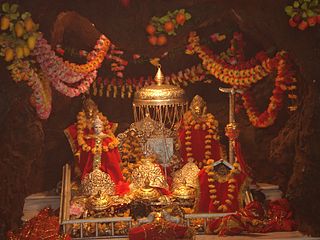
Vaishno Devi is a manifestation of the Hindu Mother Goddess, Devi. The words "Maa" and "Mata" are commonly used in India for mother, and thus are often heavily used in connection with Vaishno Devi. Vaishnavi was formed from the combined energies of Kali, Lakshmi, and Saraswati.
Mandhardevi Kalubai temple is near Wai. Located on a hill 4,650 feet above sea level, the temple, some 20 km from Satara, overlooks the picturesque Purandar fort. Devotees attribute miraculous properties to a grove around the shrine. Local lore has it that the temple is more than 400 years old and was built during Shivaji's Maratha rule; no definite date on the construction is available.
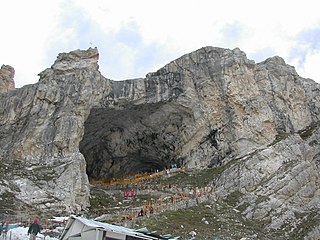
Amarnath Cave Temple is a Hindu shrine located in Jammu and Kashmir, India. The cave is situated at an altitude of 3,888 m (12,756 ft), about 141 km (88 mi) from Srinagar, the summer capital of Jammu and Kashmir, reached through Pahalgam town. The shrine represents an important part of Hinduism, and is considered to be one of the holiest shrines in Hinduism. The cave is surrounded by snowy mountains. The cave itself is covered with snow most of the year, except for a short period of time in summer when it is open to pilgrims. Hundreds of thousands of Hindus and other devotees make an annual pilgrimage to the Amarnath cave across challenging mountainous terrain.
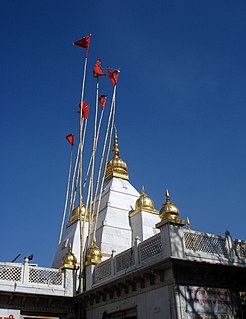
Mata Naina Devi is a town and a municipal council in Bilaspur district in the Indian state of Himachal Pradesh.

Kolluru or Kollur is a small temple-town in Byndoor Taluk in Udupi district of Karnataka state, India. It is situated about 27 km from Byndoor town. This village lies at the foot of the Western Ghats and is famous for the Mookambika temple, a Hindu pilgrim center. The village is located on the banks of Agnitheertha and Souparnika river.

Saptashrungi or Saptashringi is a site of Hindu pilgrimage, situated 60 kilometres (37 mi) from Nashik in the Indian state of Maharashtra. According to Hindu traditions, the goddess Saptashrungi Nivasini dwells within the seven mountain peaks. It is located in Nanduri, Kalwan taluka, a small village near Nashik in India. The Marathas and some Bhil tribes have been worshipping the goddess for a long time and some worship her as their Kuldaivat. There are 510 steps to climb the gad. Devotees visit this place in large numbers every day. The temple is also known popularly as one of the "three and a half Shakti Peethas" of Maharashtra. The temple is also one among the 51 Shakti Peethas located on the Indian subcontinent and is a location where one of Sati's limbs, her right arm is reported to have fallen. It is half shaktipeeth among three and a half shaktipeeth of Maharashtra.
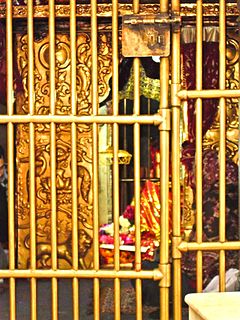
Chintpurni is a small town in the Una district of Himachal Pradesh about 40 km north of Una, not far from the border with the Indian state of Punjab. The elevation is about 977 meters. It is home to the Maa Chintpurni Temple which is a major pilgrimage site as one of the Shakti Peethas in India. The Hindu genealogy registers at Chintpurni, Himachal Pradesh are kept here. North of Chintpurni are the western Himalayas. Chintpurni lies within the much lower Shiwalik range.

Hinglaj Mata, also known as Hinglaj Devi, Hingula Devi and Nani Mandir, is a Hindu temple in Hinglaj, a town on the Makran coast in the Lasbela district of Balochistan, and is the middle of the Hingol National Park. It is one of the 51 Shakti Peethas in Shaktism denomination of Hinduism. It is one of the two Shakti Peethas in Pakistan, other being Shivaharkaray. It is a form of Durga or Devi in a mountain cavern on the banks of the Hingol River. Over the last three decades the place has gained increasing popularity and became a unifying point of reference for Pakistan's many Hindu communities. Hinglaj Yatra is the largest Hindu pilgrimage in Pakistan. More than 250,000 people take part in the Hinglaj Yathra during the spring.

Hinglaj is an important Hindu pilgrimage place in Balochistan, Pakistan and Kuldevi of many Kshatriya, Charan and other Hindu Communities of India. It is situated in Balochistan province about 250 km north of Karachi. The Shri Hinglaj Mata mandir which is the largest Hindu pilgrimage centre in Pakistan is located here.
The 2008 Naina Devi temple stampede occurred on 3 August 2008 in the Indian state of Himachal Pradesh. 146 people died and 150 were injured when they were crushed, trampled, or forced over the side of a ravine by the movement of a large panicking crowd. Witness accounts suggest that events were initiated after a rain shelter collapsed, which worshipers mistakenly took to be a landslide. There were as many as 3000 devotees at the temple because it was a sacred place in the holy month of Shraavana of the Hindu Calendar. According to Daljit Singh Manhas, a senior police officer from the area, at least 40 of the victims were children.
A human stampede occurred on 30 September 2008, at the Chamunda Devi temple in Jodhpur, Rajasthan, India, in which 224 people were killed and more than 425 injured. The 15th-century temple is dedicated to the goddess Chamunda Devi and is located within the premises of Mehrangarh Fort.
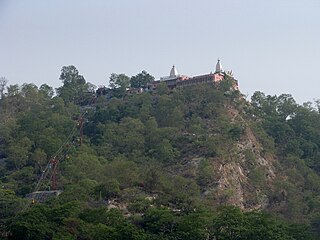
Mansa Devi Temple, Haridwar is a Hindu temple dedicated to goddess Mansa Devi in the holy city of Haridwar in the Uttarakhand state of India. The temple is located atop the Bilwa Parvat on the Sivalik Hills, the southernmost mountain chain of the Himalayas. The temple, also known as Bilwa Tirth is one of the Panch Tirth within Haridwar.

Chandi Devi Temple, Haridwar is a Hindu temple dedicated to Goddess Chandi Devi in the holy city of Haridwar in the Uttarakhand state of India. The temple is situated atop the Neel Parvat on the Eastern summit of the Sivalik Hills, the southernmost mountain chain of the Himalayas. Chandi Devi Temple was built in 1929 by Suchat Singh in his reign as the King of Kashmir. However, the main murti of Chandi Devi at the temple is said to have been installed in the 8th century by Adi Shankaracharya, one of the greatest priests of Hindu religion. The temple also known as Neel Parvat Teerth is one of the Panch Tirth located within Haridwar.

Pathibhara Devi or Mukkumlung is one of the most significant temples in Nepal, located on the hill of Taplejung. It is also considered one of the holy places for the Limbu people. Worshippers from different parts of Nepal and India flock to the temple during special occasions, as it is believed that a pilgrimage to the temple ensures fulfillment of the pilgrims' wishes.

Mahamaham Stampede was a disaster that occurred during the Mahamaham festival on 18 February 1992 around the Mahamaham tank located in the town of Kumbakonam in the South Indian state of Tamil Nadu. An estimated 50 people were killed in the stampede that left another 74 injured. The festival was attended by the then Chief Minister of Tamil Nadu, Jayalalitha, who had a holy dip in the tank.

The Vellayani Devi is a highly revered shrine in Kerala, India, dedicated to goddess Bhadrakali. The shrine is situated in Vellayani 1.5 km west of Vellayani junction, 12 km southeast of Thiruvananthapuram on the eastern bank of Vellayani Lake. The temple is under the management of Travancore Devaswom Board. The temple structure has a bronze roof with traditional art work and carries Dravidian architecture. The temple has eastern and northern towers called Gopurams with statues of different Gods sculptured in them. The Gopurams function as gateways through the walls that surround the temple complex.
On 13 October 2013, during the Hindu festival of Navratri, a stampede broke out on a bridge near the Ratangarh Mata Temple in Datia district, Madhya Pradesh, India, killing 115 people and injuring more than 110.
Mata Sartal Devi Mandir is an important Temple at Sarthal near Kishtwar in Jammu and Kashmir state of India.

The Vaishno Devi Temple is an important Hindu temple dedicated to Vaishno Devi located in Katra at the Trikuta Mountains within the Indian Union territory of Jammu and Kashmir. The temple is one of the 108 Shakti Peethas dedicated to Durga, who is worshipped as Vaishno Devi. It is one of the most visited pilgrimage centers of India. Every year millions of visitors visit the temple. During festivals like Navaratri, the count even increases to one crore visitors. Vaishno Devi Temple is one of the richest temples in India. Authors Michael Barnett and Janice Gross Stein says, "Mata Vaishno Devi Shrine in Jammu has an annual receipts of about $16 million, mainly from offerings by devotees".
References
- ↑ Mandher Devi temple deadly stampede
- ↑ Patil, Gangadhar (15 October 2013). "Madhya Pradesh temple stampede: 27 of 29 stampedes in country in last five years at religious places". dnaIndia.com. New Delhi, India: Diligent Media Corporation . Retrieved 6 July 2014.CS1 maint: discouraged parameter (link)
- ↑ "Hundreds die in pilgrimage crush". The Guardian. London.